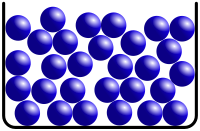
Photo from wikipedia
Abstract The phase evolution of a high flexural strength lithium disilicate (Li 2 Si 2 O 5 : LS 2 ) glass-ceramic in a complex SiO 2 –Li 2 O–Al… Click to show full abstract
Abstract The phase evolution of a high flexural strength lithium disilicate (Li 2 Si 2 O 5 : LS 2 ) glass-ceramic in a complex SiO 2 –Li 2 O–Al 2 O 3 –MgO–P 2 O 5 –ZrO 2 glass system has been investigated as a function of temperature using in situ and ex situ X-ray diffraction (XRD) and 31 P and 29 Si solid-state nuclear magnetic resonance (SSNMR) spectroscopy. In the base glass, lithium metasilicate (Li 2 SiO 3 : LS) crystallizes (at 525 °C) before LS 2 (at 675 °C). 29 Si NMR shows that LS is not only formed from the Q (2) glass species, but also by disproportionation of the Q (3) glass units. The XRD data demonstrate the formation of a minor phase of MgAl 2 Si 4 O 12 from the reaction of SiO 2 with minor components of Al 2 O 3 and MgO. Diffraction peaks of Li 3 PO 4 are firstly detected at 675 °C, and they become evident at 750 °C and above. The evolution of phosphorus species in the glass as a function of temperature has been revealed by 31 P NMR spectroscopy. Two 29 Si T 1 relaxation components were observed in samples across all temperatures, suggesting the presence of glass-in-glass phase separation in the base glass. A plot of 29 Si T 1 relaxation measurements shows discontinuity at 750 °C, indicating microstructural changes. A detailed crystallization mechanism of high-strength LS 2 glass–ceramics is proposed.
Journal Title: Journal of Non-crystalline Solids
Year Published: 2017
Link to full text (if available)
Share on Social Media: Sign Up to like & get
recommendations!